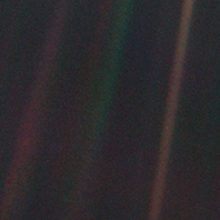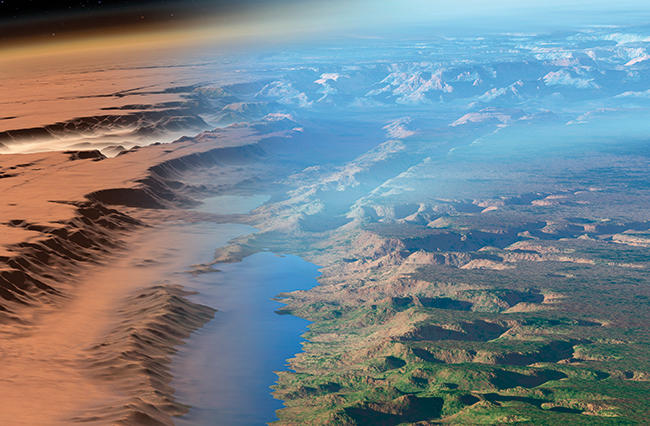Terra Firma II: terraforming Earth’s sequel
Issue: Microbiology in Popular Culture
07 November 2017 article

As E. O. Wilson wrote, we have just “one planet, one experiment” in the form of life on Earth. Implicit in his statement hides perhaps the grandest challenge to a creatively minded biologist: To build replicate biospheres on lifeless planets, populating each with a functional ecology. Rather than merely satisfying the need for experimental reproducibility at the biosphere scale, such biospheres could serve usefully as interstellar outstations of humanity.
Such notions are certainly far-fetched, but not inconceivable. This article explores the frontiers between science fiction and fact in the habitability of planetary systems. Science fiction has long imagined engineered alien biospheres within the plots of countless films and novels, arriving at the term terraforming to denote the process of developing a habitable planet, with paraterraforming describing smaller, enclosed habitable zones. As with the mobile telephone, the tablet or organ transplants, might science fiction once again presage science fact?
Lessons from science fiction
There are arguments for terraforming. These range from the innate human tendency to explore new frontiers to the lucrative prospects of mining other planets for rare elements. Such endeavours must support human life for prolonged periods off Earth. Moreover, we are presently tied to our one planet, and should our one experiment fail, it would not auger well for the future of our species. So, with the future of humanity at stake, could a terraforming microbiologist learn from science fiction?
Most immediately we are in the era of a new, synthetic biology where microbiologists and their colleagues re-design and repurpose biological systems. While the targets of present-day endeavours are predominantly genes, genomes and cells it is likely ambitions could grow in their scale and complexity, culminating in the engineering of ecosystems, biomes and indeed even biospheres. Could a synthetic biology toolkit for colonising a planet be a realistic proposition?

Shooting for the stars
Such a kit would surely draw inspiration from Star Trek’s Genesis Device, a torpedo used to transform lifeless planets into habitable environments for humanoids. However, while the Genesis Device’s mechanism for terraforming entailed reworking the planet from its subatomic particles, the synthetic biologist’s toolkit would need to install a functional suite of biogeochemical cycles to support sustainable ecosystems.
This tall order may not be impossible. Indeed, Earth’s biosphere supports complex ecosystems of extremely diverse and abundant microbes and a side-order of fauna and flora. While we currently lack a complete understanding of the intricate and intertwined nature of Earth’s biogeochemical cycles, we know that these cycles are regulated by a tiny core of conserved gene families within the inestimable diversity of Earth’s microbial genomes. Functional biogeochemical cycles exist in Earth’s most extreme environments, and these offer a ready source of enzymes and host cells evolved to withstand extremes which might be encountered on an alien planet. From these, harnessing a tightly-packed toolkit of the genes to install carbon and nutrient cycles on a lifeless planet would be relatively straightforward. With a nod to Star Trek’s Prime Directive, namely not to interfere with the inner workings of another civilisation, building in genetic circuits designed to kill the toolkit could prevent “forward contamination” of other planets. The harder part of this enterprise would simply be the waiting. For example, humans have a fairly stubborn addiction to oxygen. Around 2.45 billion years ago, thanks to oxygenic photosynthesis, oxygen became abundant in Earth’s atmosphere. To oxygenate Earth’s atmosphere took millions of years to saturate terrestrial oxygen sinks, so installing biogeochemical cycles would take rather longer than even the most epic sci-fi film franchise.
Life on another planet
But favourable climates and geochemistry on some planets might offer the terraforming microbiologist a head start. Life has four basic needs: liquid water, essential elements, catalytic surfaces and an energy source. Our metabolism and evolutionary history prejudices us towards certain forms of these ingredients, leading us to overlook potentially habitable planets and moons. As plant carbon fed dwellers of Earth’s surface we are accustomed to the generous supply of solar radiation as a foundation for life. However, beneath our feet, lithotrophic microbes breathe elements leached from the rock to grow biomass from carbon dioxide. Similarly, we may not think of the polar regions as biodiverse or productive biomes, but microbial life actually thrives upon, within and beneath the coldest glaciers on Earth, with laboratory evidence for bacterial protein synthesis even in liquid nitrogen (–196 °C).
Here, the freedom of imagination afforded by science fiction again helps us recognise potentially habitable worlds. Consider Star Wars’ Planet Hoth, an icy world synonymous with the hostile conditions inherent in unrelenting cold. As The Empire Strikes Back reveals, Hoth is home to just a few animal species in a conceptually challenging food web. Nevertheless, Planet Hoth is an excellent fictional analogue for the most likely candidates for habitable worlds elsewhere in our solar system. Six of the planets within our solar system are permanently cold, and the two best candidates for harbouring life elsewhere in our solar system are exceedingly Hoth-like. These are the ice-covered moons of Jupiter (Europa) and Saturn (Enceladus). Both possess temperature ranges warmer than liquid nitrogen and the elements required for organic carbon-based biochemistry. Thick ice surfaces would protect life within their briny subsurface oceans from radiation. Life within these Hoth-like icy moons could well be nourished near hydrothermal vents, with conditions akin to those which could have supported the origin of life on Earth. Moreover, we already know life survived for millions of years on Earth during the intensely Hoth-like conditions of “Snowball Earth” glaciations.

Human survival
Considering the likely motivations for terraforming, a fundamental challenge posed to the terraforming microbiologist is to sustain human life. This need not entail colonising an entire planet, and as many sci-fi disaster films reveal, when our survival is threatened, our innovative nature comes to the fore. Perhaps our terraforming microbiologist could learn something from a fellow biologist, Mars’s first botanist, Dr Mark Watney. The hero of The Martian may have a PhD in plant biology, but it is his microbes that help save him. Trapped on Mars, Watney is forced to supplement his rations by growing potatoes within the shelter of his “Hab” station. To achieve this feat of para-terraforming requires improvisational genius, explosive rocket fuel and no small amount of duct tape. But Watney’s key challenge is to provision the Martian soil with organic matter, nutrients and viable microbes to sustain his potato crop. In stark contrast to a high-tech synthetic biology Genesis Device, he can only use his own freeze-dried faeces as fertiliser, a practice which has supported agriculture for millennia in the form of nightsoil. In a sci-fi film at pains to retain credibility, Watney’s struggle for survival and his emaciated condition highlight just how much of a challenge staying alive would be for just one human terraforming less than a hundred square metres of Mars.
So, if our aspiring terraforming microbiologist learns anything from sci-fi it is that to terraform another planet may not be impossible, just exceedingly difficult. Success would require life to survive challenging conditions, some very innovative thinking, and the capability to understand and sustain complex biogeochemical cycles to promote life. In other words, a shortlist of talents which coincidentally starts to resemble the essentials for making a success of our one planet, our one experiment!
Arwyn Edwards
Interdisciplinary Centre for Environmental Microbiology (IBERS), Aberystwyth University, Ceredigion SY23 3DD
[email protected]
Further reading
Falkowski, P. G., Fenchel, T. & Delong, E. F. (2008). The microbial engines that drive Earth’s biogeochemical cycles. Science 320(5879), 1034–1039.
Garcia-Lopez, E. & Cid, C. (2017). Glaciers and ice sheets as analogue environments of potentially habitable icy worlds. Front Microbiol 8,1407.
Menezes, A. A. & others (2015). Towards synthetic biological approaches to resource utilization on space missions. J R Soc Interface 12(102), 20140715.
Images: The Pale Blue Dot of our solar system taken at a distance of 4 billion miles by the Voyager I space probe. This first snapshot of our solar system conceals both our own inhabited planet and potential candidates for habitable worlds. NASA/JPL. Computer artwork of Mars before (left) and after (right) terraformation. Detlev van Ravenswaay/Science Photo Library.


